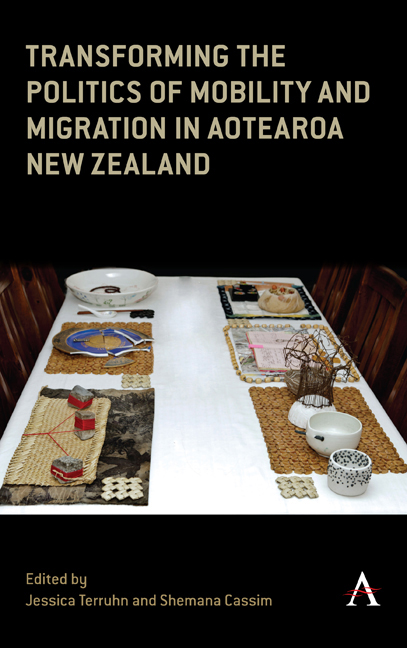Book contents
- Frontmatter
- Contents
- Acknowledgements
- Contributors
- Glossary of Te Reo Māori Words
- Glossary of Te Reo Māori Place Names
- Glossary of Other Non-English Words
- List of Tables
- List of Figures
- Introduction: Reimagining the Politics of Mobility and Migration Through Decolonisation, Social Justice and Solidarities
- Cover Artwork: A Place at the Kauri Table Revisited … 2021
- Part One Decolonising the Politics of Migration
- Part Two Humanising the Politics of Transnational Mobility
- Part Three Building Solidarities for Migrant Rights and Belonging
- Conclusion: Towards Transforming the Politics of Mobility and Migration in Aotearoa New Zealand
- Index
One - When Worlds Collide: Māori and Immigration
Published online by Cambridge University Press: 28 February 2024
- Frontmatter
- Contents
- Acknowledgements
- Contributors
- Glossary of Te Reo Māori Words
- Glossary of Te Reo Māori Place Names
- Glossary of Other Non-English Words
- List of Tables
- List of Figures
- Introduction: Reimagining the Politics of Mobility and Migration Through Decolonisation, Social Justice and Solidarities
- Cover Artwork: A Place at the Kauri Table Revisited … 2021
- Part One Decolonising the Politics of Migration
- Part Two Humanising the Politics of Transnational Mobility
- Part Three Building Solidarities for Migrant Rights and Belonging
- Conclusion: Towards Transforming the Politics of Mobility and Migration in Aotearoa New Zealand
- Index
Summary
Introduction
On 5 June 1863, amid spiralling conflict between Māori and settlers in Te Ika-a-Māui (the North Island), Arthur Samuel Atkinson, White supremacist and immigrant to Aotearoa New Zealand (hereafter, Aotearoa) from County Durham in England, wrote in his journal that ‘I find one lies in wait to shoot Maoris without any approach to an angry feeling – it is a sort of scientific duty’ (Atkinson 1863, 49). Five years later, in November 1868, John Bryce, White supremacist, politician and immigrant from Glasgow, Scotland, led a patrol of volunteer settler cavalry on the Nukumaru flats in south Taranaki. Bryce and his troops chanced upon a group of unarmed Māori children who were chasing pigs and geese near William Handley's woolshed. The soldiers charged at the children killing two young boys and wounding others (Riseborough [1993] 2022). Bryce was henceforth known to local Māori as Bryce Kōhuru or Bryce the murderer, a reputation that can only have been strengthened after he led the invasion of the pacifist settlement at Parihaka (Ray 2018; Riseborough [1993] 2022).
This wave of White-supremacist vitriol and violence carried to Aotearoa by European migrants was not limited to the nineteenth century, nor were Māori the only victims of it. On 24 September 1905, John Terry, White supremacist and recent immigrant from Kent, England, shot and killed an elderly Chinese man, Joe Kum Yung, on Haining Street in Wellington. Terry, who was fervently racist to the point of obsession, committed the murder in hope of raising the profile of his book of White-supremacist verse The Shadow (Ray 2019; Tod 1996). Some years later, on 3 January 1921, White supremacist and immigrant from Limavady, Northern Ireland, then-Prime Minister William F. Massey penned a New Year's message to the people of Aotearoa. In it, Massey wrote that ‘Nature intended New Zealand to be a white man's country, and it must be kept as such. The strain of Polynesian will be no detriment’ (Massey 1921, 5). Massey also spoke openly of his aversion to Chinese people, telling the House: ‘I am not a lover or admirer of the Chinese race … I should be one of the very first to insist on very drastic legislation to prevent them coming here in any numbers’ (Massey 1910, 402).
- Type
- Chapter
- Information
- Publisher: Anthem PressPrint publication year: 2023



